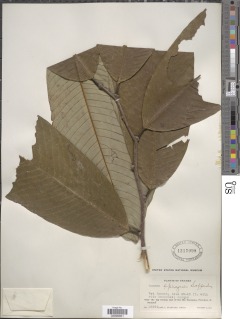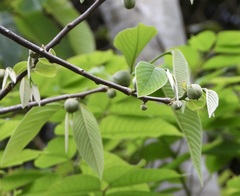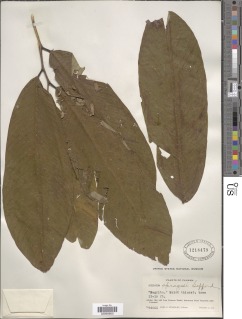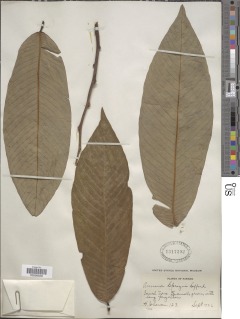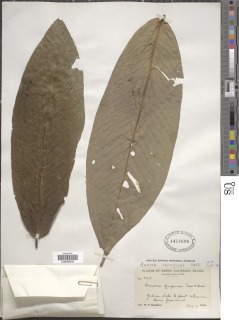

|
|
|
|
Family: Annonaceae
chirimoya, more...nonita de mono, toreta
[Annona uncinata Sprague] |
Description: Small or medium-sized tree. Leaves are simple and alternate, arranged very regularly along branches, in a flat plane. Underside is light green, and there are many secondary veins, straight and parallel, easily visible. Bark is dark spotted with green or gray. Reproduction: Leaves turn yellow during the dry season; some individuals are partly or fully leafless. Flowers are solitary on branches at leaf bases, yellowish outside but purple inside, mature from February to June, pollinated by beetles. Fruit is fairly large, with flexible green spines, produced from July to September. Distribution: A very common roadside tree in the Canal area, from Panama City to Gamboa, along Pipeline Rd., and around the Sherman-San Lorenzo area on the Caribbean coast. Less common in forests, only in natural tree-fall clearings. Similar Species: Along roads the most similar species are LK castel Castilla elastica LK2 and LK apeiti Apeiba tibourbou, LK2 both of which have leaves of the same size and shape, alternate, in a flat plane. Both have quite different venation, with many fewer secondary veins. In the forest, several other Annonaceae have similar leaf patterns, especially LK guatam Guatteria amplifolia, LK2 LK unonpi Unonopsis pittieri. LK2 But none has the combination of light-colored leaf undersides and numerous, straight secondary veins that distinguish A. spraguei. Uses: The fruit pulp is edible but not sold in markets. Descripción: Árbol de 5 a 20 m de alto. Tronco recto y cilíndrico. Corteza exterior gris o negra y con manchas verdes o gris, desprendiéndose en tiras largas al romperse las ramas. Hojas simples y alternas, de 15-30 x 6-11 cm, oblongas o lanceoladas, con ápice agudo, bordes enteros y base redondeada. Las hojas son verdes en el haz y blancas o grises por el envés, cubiertas de pelos suaves y de textura aterciopelada al tacto. Pecíolo de 0.5-1.5 cm de largo y ligeramente acanalado en la parte superior. Flores solitarias, verdes o amarillentas en el exterior y rojas en el interior. Frutos globosos a ovoides, de 4-8 cm de largo, verdes y con proyecciones externas a manera de pelos o espinas flexibles, tornándose amarillos al madurar. Semillas rodeadas por un arilo blanco. Datos Ecológicos: La especie crece a bajas y medianas elevaciones, en bosques húmedos o muy húmedos. En Panamá se encuentra en las provincias de Colón, Darién, Panamá y la comarca de Guna Yala. Deja caer sus hojas totalmente durante la estación seca, pero las repone a inicios de la estación lluviosa; antes de caer las hojas se tornan amarillas en la copa del árbol. Florece y fructifica de febrero a octubre. Especies Parecidas: A menudo se confunde con LK annopu Annona purpurea LK2 , pero en A. purpurea los frutos son de mayor tamaño y presentan proyecciones cónicas en el exterior. También se puede confundir con LK unonpi Unonopsis pittieri LK2 , pero en U. pittieri los frutos son monocarpos globosos y las semillas tienen forma de ‘hamburguesa’. LK castel Castilla elastica LK2 tiene hojas parecidas, pero C. elastica presenta savia lechosa y los bordes de la hoja son aserrados. Usos: La madera es empleada en construcciones rurales. La pulpa de los frutos maduros es comestible. Chirimoya, Negrito Tree, to 15 m tall; outer bark thin, with broad shallow fissures in young trees; inner bark thin; branchlets tomentose when young, glabrous in age; sap at first with pungent odor, soon fading. Leaves deciduous, short-pilose all over, more sparsely above; petioles 5-15 mm long; blades oblong-lanceolate to narrowly elliptic, acuminate, rounded to obtuse at base, 15-30 cm long, 6-11 cm wide. Flowers solitary, arising between nodes, globose in bud, on pedicels 1-2 cm long; sepals 3, connate at base, the lobes deltoid, to 1.3 cm long; petals 3, valvate, to 6 mm thick, broadly ovate, acute at apex, to 3 cm long, moderately pubescent outside with a purple spot inside near base; stamens numerous, ca 4 mm long. Fruits fleshy aggregates, +/- globose, to 6 cm diam, green, shaggy with dense, long-attenuate protuberances; seeds many, l per carpet, oblong, to 1 cm long. Croat 5070, 6750. Frequent in the forest, especially in the young forest. Leaves are lost in the middle of the dry season. The flowers often appear at the same time as the new leaves, usually from February to June. The fruits are probably mature from June to October. See Fig. 235. |
|
|
|
































